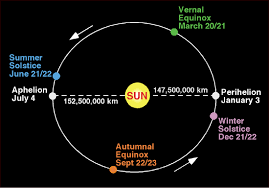The purpose of this blog is to brighten the Shabbat table. Please share.
 As some people are heading to sunnier or snowier climates, here's an original riddle for your table tonight:
As some people are heading to sunnier or snowier climates, here's an original riddle for your table tonight:
What's the sunniest time of year?
Hint: since it's a riddle, you know the answer is not going to be at the summer solstice.
Another hint: The correct answer also does not depend on which hemisphere you're in.
Still stumped?
Here's another hint, in the form of a know-thy-planet question:
Why is it colder in the winter and warmer in the summer?
(It always amazes me how many adults can't answer this.)
Before you answer, think about the fact that today it's summertime in Sidney right now.
Hmm....
OK, since most people are by now totally stumped, here is the answer....
The Earth orbits the sun in an elipse, not a circle.
 That means that at times we are closer to the sun (perihelion) and at times farther from the sun (apihelion).
That means that at times we are closer to the sun (perihelion) and at times farther from the sun (apihelion).
The difference between our perihelion and apihelion is about three million miles.
It happens to be that now, in the alleged start of the winter in the northern hemisphere, we are reaching perihelion. That means we are millions of miles closer to the sun now than we are in June.
These are facts.
So as a planet, now begins the sunniest time of the year - peaking at about January 4.
If the riddle fooled you, it was perhaps because you were thinking locally, not globally?
By the way, here's another fact about our orbit that may be somewhat disconcerting: it isn't constant. This year's exact perihelion is on January 3 at 12:19 am (NY time). Next year it will be on January 5.
Another fact to entertain your table: we're moving faster at perihelion than aphelion. That means that our winters are shorter than our summers.
And another interesting idea - these changes in our orbit plus fluctuations in the sun's output do affect our weather but probably not global warming.
The amount of sunlight reaching the earth varies for other reasons, including sunspots and this eliptical business. The eliptical orbit itself causes a variation over the year of about 100W per square meter.
Final question for your table: What's more amazing, the ways of the heavens and the earth, or the human minds who can measure and predict it with great precision and appreciate it?
Shabbat Shalom
 As some people are heading to sunnier or snowier climates, here's an original riddle for your table tonight:
As some people are heading to sunnier or snowier climates, here's an original riddle for your table tonight:What's the sunniest time of year?
Hint: since it's a riddle, you know the answer is not going to be at the summer solstice.
Another hint: The correct answer also does not depend on which hemisphere you're in.
Still stumped?
Here's another hint, in the form of a know-thy-planet question:
Why is it colder in the winter and warmer in the summer?
(It always amazes me how many adults can't answer this.)
Before you answer, think about the fact that today it's summertime in Sidney right now.
Hmm....
OK, since most people are by now totally stumped, here is the answer....
The Earth orbits the sun in an elipse, not a circle.
The difference between our perihelion and apihelion is about three million miles.
It happens to be that now, in the alleged start of the winter in the northern hemisphere, we are reaching perihelion. That means we are millions of miles closer to the sun now than we are in June.
These are facts.
So as a planet, now begins the sunniest time of the year - peaking at about January 4.
If the riddle fooled you, it was perhaps because you were thinking locally, not globally?
By the way, here's another fact about our orbit that may be somewhat disconcerting: it isn't constant. This year's exact perihelion is on January 3 at 12:19 am (NY time). Next year it will be on January 5.
Another fact to entertain your table: we're moving faster at perihelion than aphelion. That means that our winters are shorter than our summers.
And another interesting idea - these changes in our orbit plus fluctuations in the sun's output do affect our weather but probably not global warming.
The amount of sunlight reaching the earth varies for other reasons, including sunspots and this eliptical business. The eliptical orbit itself causes a variation over the year of about 100W per square meter.
Final question for your table: What's more amazing, the ways of the heavens and the earth, or the human minds who can measure and predict it with great precision and appreciate it?
Shabbat Shalom
(and Happy Solstice)
PS - Yes, as usual, the pic above contains a surprise link.
PS - Yes, as usual, the pic above contains a surprise link.
Enjoyed this Table Talk? Go ahead and Like, Tweet, or forward it....
1 comment:
I will be happy if you read my comment. I must say that I like all your posts and wait for new ones. That's because they seem so great and suitable for me. Thanks a ton for uploading your articles.Abc ya free games || y8 games online ||friv free games
Post a Comment